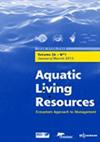Effects of a lagoon on performances of a freshwater fishpond in a multi-trophic aquaculture system
IF 1.9
4区 农林科学
Q3 FISHERIES
引用次数: 0
Abstract
Integrated multi-trophic aquaculture (IMTA) is a way to help preserve the environment while maintaining a good level of total production. An ecologically semi-intensive pond system was designed in which a polyculture fishpond was associated with a lagoon planted with macrophytes to bioremediate the water. The properties of this “semi-intensive coupled” system (SIC) were compared to those of semi-intensive (SI) and extensive (E) systems, each of which was contained in a single fishpond with the same fish polyculture (common carp (Cyprinus carpio), roach (Rutilus rutilus), and perch (Perca fluviatilis)) as SIC. E differed in that it had half the initial density of fish, and the fish were not fed. Fish growth performances, water quality (chemical and biological indicators), chlorophyll concentrations, and invertebrate production were measured. The systems were compared based on fish production performances and physicochemical and biological characteristics, and were then described using principal component analysis (PCA). Carp and roach in the two fed systems had higher growth performances than those in E. Compared to SI, the planted lagoon in SIC, induced a decrease of 15% in fish growth performances and of 83% in total chlorophyll concentration (a proxy for phytoplankton) but improved water quality (−34%, −60% and −80%, for the concentrations of total nitrogen, total phosphorus, and blue green algae (for micro-algae in class Cyanophyceae), respectively). According to the PCA, SIC clearly differed from SI in benthic macro-invertebrate production and concentrations of total nitrogen, total phosphorus, and brown algae (for micro-algae in class Dinophyceae or a branch of Bacillariophyta) in the water. SIC differed from E in oxygen parameters (dissolved and saturation), estimated annual zooplankton production, and pH. In conclusion, the properties of a lagoon reveal perspectives for environmentally friendly practices, while using biodiversity and secondary production in order to enhance fish production.
泻湖对多营养养殖系统中淡水塘性能的影响
综合多营养水产养殖(IMTA)是在保持良好总产量水平的同时帮助保护环境的一种方法。设计了一个生态半集约化池塘系统,其中一个混养鱼池与一个种植了大型植物的泻湖相关联,以生物修复水。将这种“半集约化耦合”系统(SIC)的特性与半集约化(SI)和粗放化(E)系统的特性进行了比较,这两种系统都是在同一个鱼池中,与SIC相同的鱼类混养(鲤鱼(Cyprinus carpio)、蟑螂(Rutilus Rutilus)和鲈鱼(Perca fluviatilis))。E的不同之处在于它的初始密度是鱼的一半,而且鱼没有被喂食。测量了鱼的生长性能、水质(化学和生物指标)、叶绿素浓度和无脊椎动物产量。基于鱼类生产性能和理化生物学特性对系统进行了比较,然后使用主成分分析(PCA)进行了描述。两种饵料系统中鲤鱼和蟑螂的生长性能均高于e。与SI相比,SIC中人工泻湖导致鱼类生长性能下降15%,总叶绿素浓度(浮游植物的代表)下降83%,但水质得到改善(总氮、总磷和蓝绿藻(蓝藻类微藻)浓度分别下降- 34%、- 60%和- 80%)。根据主成分分析,SIC与SI在底栖大型无脊椎动物产量以及水中总氮、总磷和褐藻(用于硅藻纲或硅藻纲的一个分支的微藻)的浓度方面存在明显差异。SIC与E在氧参数(溶解和饱和)、浮游动物年产量和ph值方面存在差异。总之,泻湖的特性揭示了环境友好实践的前景,同时利用生物多样性和二次生产来提高鱼类产量。
本文章由计算机程序翻译,如有差异,请以英文原文为准。
求助全文
约1分钟内获得全文
求助全文
来源期刊

Aquatic Living Resources
农林科学-海洋与淡水生物学
CiteScore
2.30
自引率
0.00%
发文量
10
审稿时长
>24 weeks
期刊介绍:
Aquatic Living Resources publishes original research papers, review articles and propective notes dealing with all exploited (i.e. fished or farmed) living resources in marine, brackish and freshwater environments.
Priority is given to ecosystem-based approaches to the study of fishery and aquaculture social-ecological systems, including biological, ecological, economic and social dimensions.
Research on the development of interdisciplinary methods and tools which can usefully support the design, implementation and evaluation of alternative management strategies for fisheries and/or aquaculture systems at different scales is particularly welcome by the journal. This includes the exploration of scenarios and strategies for the conservation of aquatic biodiversity and research relating to the development of integrated assessment approaches aimed at ensuring sustainable and high quality uses of aquatic living resources.
 求助内容:
求助内容: 应助结果提醒方式:
应助结果提醒方式:


